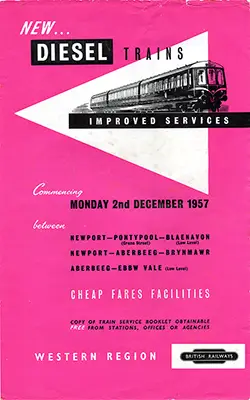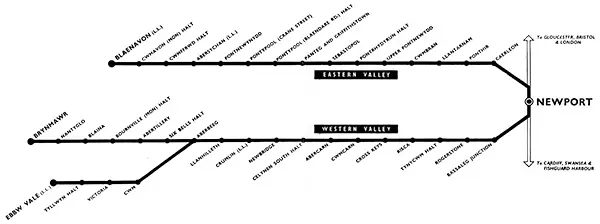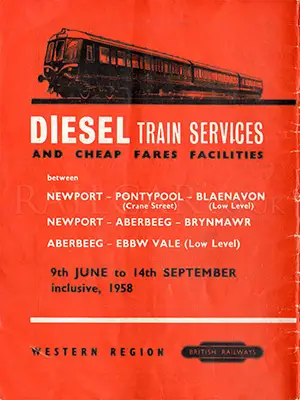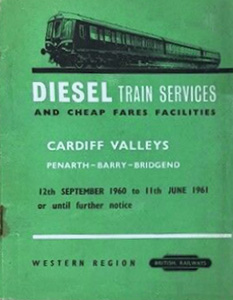Class 116 Derby 3-car Suburban DMUs
Operations - South Wales
By July 1957 Cardiff was supposed to have had 29 sets delivered in preparation for winter services but none had arrived by that date. Deliveries began in August 1957 when the final 13 sets of batch one began to arrive. There were three sets at Newport, where they were supposed to begin on the Blaenavon, Brynmawr, Aberbeeg and Ebbw Vale branches from August 1957, but this was postponed to 16/9/57.
116s were "in evidence" at Pontnewynydd and Newport but they were not in public service by 10/10/57, and steam locos were again finding it hard working to the modified timetable drawn up in anticipation of the DMUs introduction on the 16/9/57.
On the 13th October 1957 50085/59035/50127 (destined for Cardiff) were in the works of Leyland Motors on the downside of the WCML at Leyland[1]. It has been quoted that it was there for trials with more powerful engines, although there is no further info on this, and it would be the Derby Heavyweights (later Class 114s) that would be trialled with a more powerful engine at aournd this time - the Leyland Albion engine.
At London Liverpool Street on the 25th November 1957 were 50819/59327/50872 for official inspection. One blind was showing ‘Rhymney’. This was the second set of the batch two which would all (53 sets) be delivered to Cardiff between November 1957 and July 1958.

The first South Wales services were introduced on the 2nd December 1957 comprising the majority of services to/from the Eastern & Western Valleys between Newport and Blaenavon, and Newport, Brynmawr and Ebbw Vale (Low Level). They were worked by ten 116 sets with only 2nd class.

They were introduced to regular working in the Cardiff Valley’s on Monday the 13th January 1958. There were two turns that day from Barry (88C). Both were worked by 6-car sets. The first started with the 05:35 Barry Island - Treherbert and ended with the 11:30 Treherbert - Barry island, being replaced by a steam train for the rest of the day. The other diagram began with the 06:50 Barry - Aberdare Low Level, and continued with subsequent trips between Barry Island and Merthyr, ending with the 21:00 Methyr - Llantwit (with a mail van attached to it at Cardiff). On that day there were three other 6-car sets noted in the sidings at Barry.
1958
Six 6-car sets were working on the TVR from 10/2/58, although certain sets finished with the early turn of duty, being replaced by steam for the later half of the day. By mid-Feb 22 3-car sets were noted in the Cardiff Valleys Division and it was hoped that all the services would be DMU worked in the summer timetable.
On the 10/3/58 Treherbert increased its diesel workings from 2 to 4, this making, with Barry, a total of 8 6-car sets working over the whole of the TVR. On the same day the local service between Pontypridd, Abercynon and Aberdare (LL), formerly worked by two push-and-pull sets, was taken over by two 3-car sets. The rush hour extra through trains between Cardiff and Aberdare were still steam hauled. Two 2-car sets (the power cars from 3-cars) were noted working from Barry, and 3-car sets had been working on trial on the Rhymney main line.
The rosters for the Cardiff Valley lines at the time were as follows:
Duty BA: 3-car set, covered Barry - Cardiff and back to Aberthaw, ran then to Pontypridd via Wenvoe and back to Cadoxton, next making for Creigiau and on to Clarence Road via St Fagans; after two trips from Cardiff to Penarth, from the second of which it returned to Barry. The set's evening work covered Barry - Cardiff - Penarth - Llantwit Major and ended just before midnight.
Duty BB: 6-car set, left Barry at 05:35 for two morning trips to Treherbert, followed in the afternoon by two trips to Merthyr, after the second of which the return run was through to Llantwit Major, a total of over 280 miles.
Duty BC: 6-car set, two morning return trips between Barry and Merthyr and two between Barry and Treherbert in the afternoon, a total of 260 miles.
Duty BD: 6-car set, covered Barry - Llantwit Major - Merthyr - Barry Island - Treherbert - Pontypridd - Merthyr - Barry.
Duty BF: 6-car set, covered Barry - Aberdare - Barry - Merthyr - Barry - Cardiff (Clarence Road) - Llantwit Major - Barry - Merthyr - Llantwit Major.
Duty BG: 3-car set, covered Barry - Llantwit Major services until working the 16:55 Barry - Pontypridd via Wenvoe and a return trip, after which it returned to Llantwit Major and back to Bridgend and back.
Several of the Cardiff sets were noted working in the Birmingham area during February / March 1958. They had indicator blinds for the South Wales area. Those noted were in the series 50830-51/59338-59/50883-904.
Around April 1958 all the sets started to carry a small plate- 'CAT 300', 'CAT 301' etc which indicated the set number and the area in which they were based, 'CAT' indicating Cathays (Cardiff). At this time this shed was still being converted for diesel use, hence the workings beginning from a temporary base at Barry. They were sent to Cardiff Canton at 3,000 mile intervals for inspection.
Further diesel sheds were set up at Treherbert and Rhymney, and four Treherbert duties to Barry were soon dieselised, turns TA, TB, TC and TD, using 6-car sets, as were turns FA and FB on the Porth and Ferndale branch with 3-car sets, and AA and AB also with 3-cars on the Aberdare and Abercynon branch.
By April 1958 Barry had four 3-car sets to work three new diesel diagrams. The Maerdy - Porth branch was now 116 worked, with the trailer removed (again lack of power was blamed!). On the 30th March two power twins were noted at Ferndale (50879/50826 & 50857/50910).

On the 21st April 1958 they started working on the Rhymney Valley line (stage four of the Cardiff Valleys diesel scheme), although a few trains were still steam operated on this day. Four DMU services were introduced on the Rhymney section, affecting six steam diagrams. In some cases two former steam diagrams were merged into one DMU diagram.
From either the 28th April or the 5th May 1958 two of the former Merthry steam turns were dieselised, MA & MC, both involving through running to Barry Island as part of the regular interval services. The fitting of fuelling facilities allowed diesel workings to spread to Cathays on Monday the 9th June, displacing yet more steam in the valleys, particularly in the Rhymney Valley. The Valleys services were then over 80% DMU operated. The DMUs allowed the elimination of the two-hour mid-morning break that steam locos required for re-coalling etc. The DMU diagrams now gave a continuous four-hour cycle on the Barry Island - Treherbert and Barry Island - Merthyr services. The 04:30 ex-Treherbert made five return trips covering twenty hours. Sets also now worked some of the Coryton branch trains, and the Senghenydd branch was DMU worked from the 9th June.

The image shows a set at Senghenydd in the Aber Valley, date unknown. Stuart Mackay Collection.
London
Delayed deliveries of the Pressed Steel suburban DMUs (later Class 117s) caused a crisis on the Western Region London Operating District towards the end of 1959. An attempt had been made to work the new diesel timings in the Winter timetable with steam trains resulted in DMU sets being borrowed from Cardiff, and Derby Lightweight sets were borrowed from South Gosforth to fill the gap.

Afan Valley Collision
The first withdrawal occurred in 1961 after a fatal head-on collision in the Afan valley, South Wales on the 24th November 1960. The unit concerned was CAT343 (consisting of W50083/W59343/W50125[2]), which was operating the 4.55pm Swansea High Street to Barry Island when the leading car, W50125 was struck by a runaway coal train headed by ex-GWR pannier tank 9737, on the single line track at Pontrhydyfen Junction. Sadly the DMU driver was killed in the accident and the leading car was so badly damaged that it was written off and later scrapped at Swindon Works.
Trailer W59033, which had been replaced in CAT343 by 59343 before the accident, had found a new home between W51139 and W51152 one of the last batch of 116s built.
The other CAT343 power car W50083 went on to lead a nomadic life at various WR depots as a spare. When Reading lost a Class 117 DMBS (51357) in April 1968 50083 moved there and would run in its place until moving to Laira in 1982. Eventually, as 53083 becoming one of only two Class 116 units to appear in Network South East livery.
The other vehicle in NSE livery was 53820, which became 50083’s partner at Plymouth Laira (LA) in set P307 and later at Cardiff Canton (CF) as C307, — becoming one of Cardiff’s oddest 3-car units, easily identified as 53820 later sported a white cab roof dome and red painted buffer beam while in the blue and grey livery (mimicking the Buxton allocated 104 and 108 units); along with various ‘Valley Lines’ adornments. As well as both cars being DMBS vehicles, operating with three different trailers in as many years, these were of Class 118, 101 and 116. Reduced to a 2-car twin in 1987 before moving to Old Oak Common as 2-car parcels unit L307. Both vehicles returning to revenue earning duty though in separate sets, before ending their days at MC Metals Glasgow in December 1992. The other notably odd 3-car unit was numbered C396 and consisted of one Derby Class 108 TBS(L) 59245 sandwiched between two ex-Tyseley DMBS cars, 51133 and 51136.
The class, as well as others, feature prominately in the video "A Day on the Valley Lines" by Ian Walmsley.
Experiment
Set CAT404 received lower ratio final drive gearing to assist operation on the steeply graded eastern valley services out of Newport and was dedicated to these services until the closure of the eastern valley network to passenger services, on the 30th April 1962. As a matter of interest the last passenger working from Blaenavon to Newport was worked by set CAT328 W50842/W59328/W50895 and it is noteworthy that although the power cars are correctly paired the trailer was from another set, the correct trailer W59350 was later recorded in this set.

In the image W51140 is seen at the front of the 2.33pm Ebbw Vale to Aberbeeg service on April 23, 1962. Michael Mensing.
Replacement
1987 saw the introduction of Class 150/2 Sprinter units onto Valley Line services at Cardiff. It was the decided to remove all the trailer cars from the Cardiff 116 fleet which by this stage contained a few ex-Laira 118s. This was done to improve the power to weight ratio of these units as they were diagrammed to work alongside Sprinters on the new tighter timetables, which it was thought they could not do as 3-car units.
An article by Phil Evans includes details of 116s encountered while using a Valley Lines Day Rover in July 1987.

The image shows two-car set C395 at Cardiff on 3/1/89. Norman Cross.
The passenger numbers had been increasing dramatically during the mid 1980s due to a fare pricing policy introduced locally and against the national fare structure prevailing in England, but now with less seats available fares had to rise to d’etre ridership and therefore reduce over crowding, does it sound familiar? As more Sprinters were received more heritage 116s were withdrawn and stored, some sets moving to work out their last year or two at depots such as Manchester’s Newton Heath, Chester and even as far a field as Heaton in Newcastle. The remaining units were all fitted with high intensity head lights at about this time. Then came the bomb shell that the operating authorities didn’t envisage, the Class 155 Sprinters of which Cardiff had 35 sets, were grounded due to passenger door problems. This caused chaos to Valley Lines with heritage units being sought from anywhere to plug the gaps, as Class 150s and diverted Scottish allocation of Class 156 Sprinters were assigned to the long distance services diagrammed for the 155s. A small fleet of Class 101 vehicles were acquired but the unit shortage was such that Class 116 units were hired on a regular basis on rugby match days and at the weekends leading up to the Christmas holidays when the Tyseley sets would have been idle at their home depot. This saw the operation of units which were transferred from Cardiff years before, albeit now with trailers who’s origins were on the Midland line to Bedford.
On September 18th 1992 the eight remaining power cars at Cardiff Canton were transferred to Tyseley.
References
The Railway Observer is the journal of the Railway Correspondence and Travel Society
Summary
Description
Modifications
Works Photographs
Diagrams
Numbering
Drivers Instructions
Liveries
Operations
- South Wales
- Scotland
Accidents
Railair Express Parcels set
Parcel Use
Refurbishment
Hybrids
Decline
Departmental Use
Images
Details about preserved Class 116s can be found here.
Thanks to Mac Winfield, Ian Fleming and John Thomlinson for much of the information on this Class.


